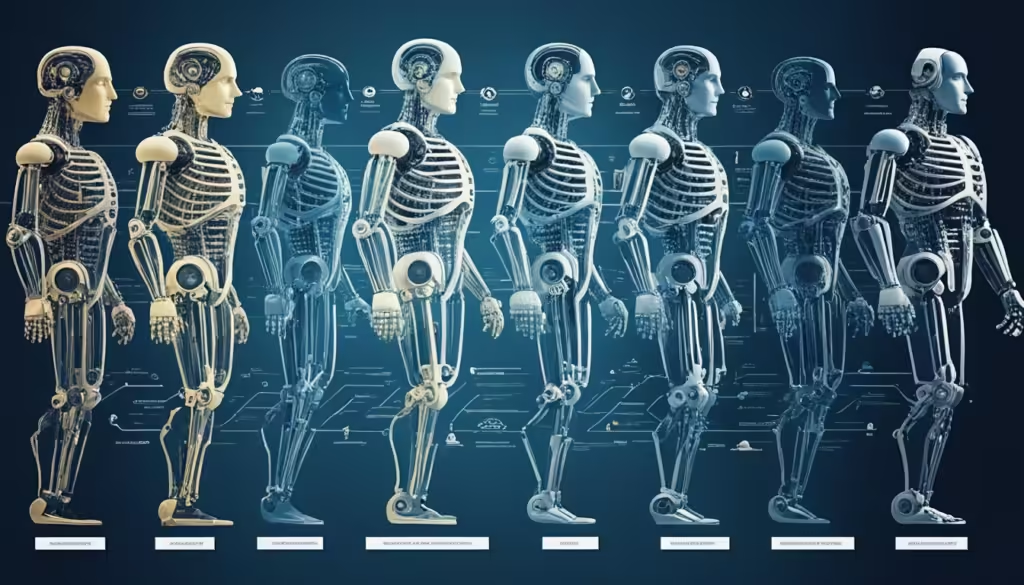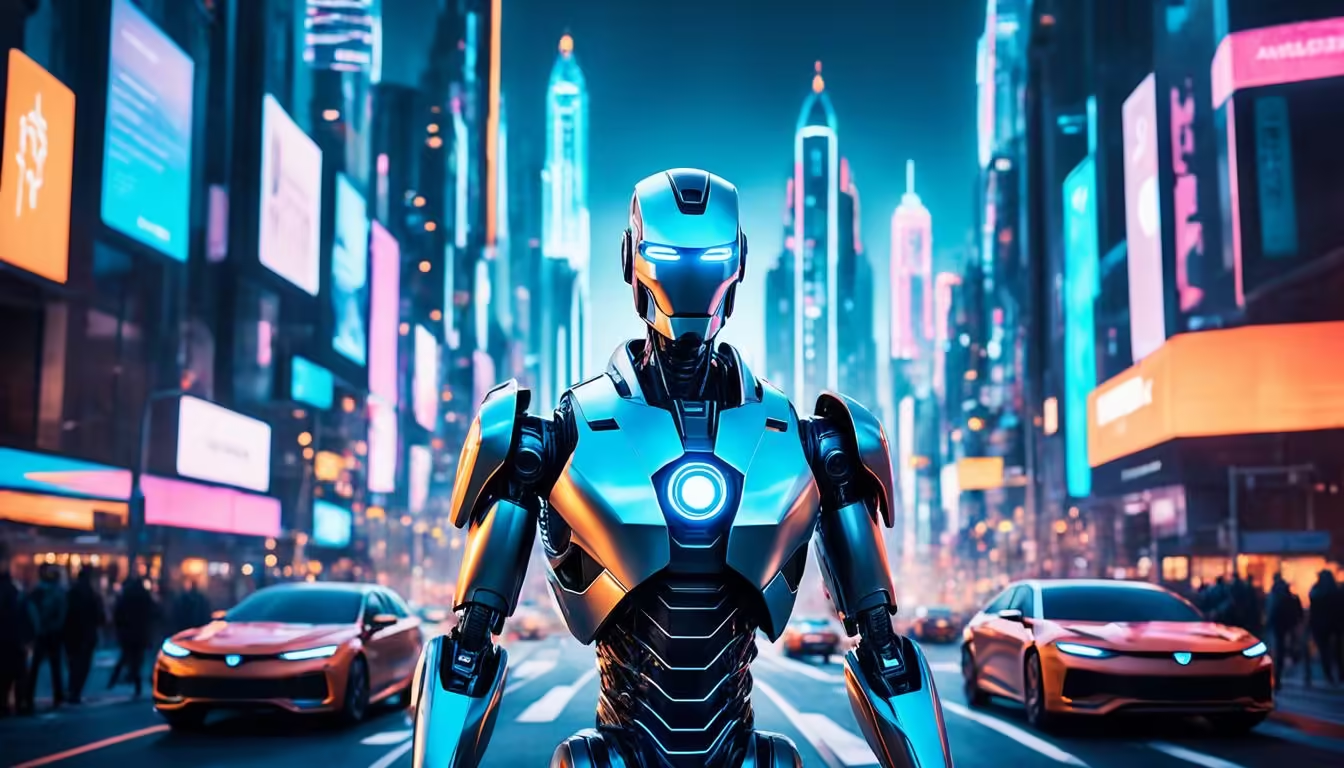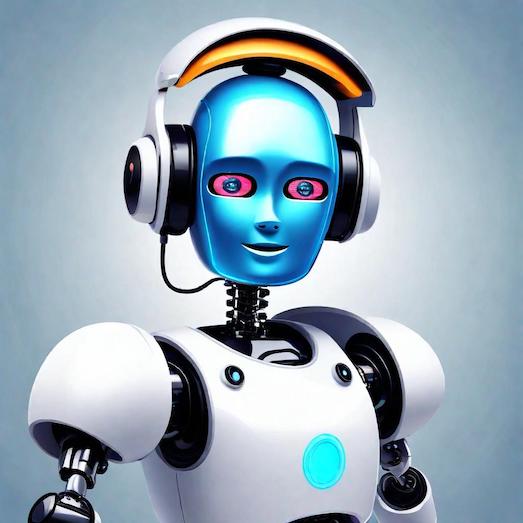Artificial intelligence (AI) is changing how we live and work fast. It includes many areas like machine learning and natural language processing. These aim to make machines think like us, doing tasks that need human smarts.
AI has been around for years, but new tech has made it more powerful. Now, it’s seen as a key technology for our time.
AI is making a big mark in many fields, from healthcare to finance. It helps automate tasks, make better decisions, and give customers more personalized experiences. In healthcare, AI is helping find new drugs and tailor treatments. In education, it’s making learning more tailored to each student.
The future of AI looks bright, with big hopes to tackle big challenges. These include fighting climate change and preventing diseases.
As AI keeps getting better, its effects on society will too. Some worry about losing jobs and privacy issues, but AI’s benefits are clear. By embracing AI, we can make the world better in many ways. It could improve healthcare, education, and boost the economy.
Key Takeaways
- AI is a rapidly growing field that encompasses machine learning, natural language processing, computer vision, and robotics.
- Recent advancements in computing power and big data have propelled AI to new heights.
- AI is being applied across various industries, including healthcare, education, finance, and transportation.
- The future of AI holds immense potential to solve complex problems and drive progress.
- Embracing AI technology and preparing for the future is crucial to harnessing its benefits for society.
Introduction to Artificial Intelligence

Artificial Intelligence (AI) is a fast-growing field that aims to make machines smarter. These machines can do tasks that usually need human smarts, like solving problems and making decisions. AI wants to make systems that think like humans or even better in some areas. It has the power to change how businesses work and affect society in big ways.
AI includes important areas like machine learning, understanding human language, and seeing the world through cameras. These basics help make smart systems that can learn from data and talk like us. By understanding these AI basics, experts can make powerful tools that use AI’s strengths.
| Types of AI | Description |
|---|---|
| Weak AI | AI systems designed to perform specific tasks only, excelling at designated functions but lacking general intelligence. |
| Strong AI | AI with the capability to possess human-level intelligence or even surpass human intelligence across a wide range of tasks. |
The main goal of AI is to make machines think like the human brain. This is called artificial general intelligence (AGI). AGI systems could do any intellectual task a human can, faster and more accurately. While AGI is a long-term goal, narrow AI is already making big changes in many areas.
AI will have a huge impact, adding $15.7 trillion to the global economy by 2035. China and the U.S. will see most of this growth, making up almost 70% of it. As AI gets better, it will bring new growth and change how we work in many fields, from moving people to making movies to helping in healthcare and finance.
To really understand AI, we need to look at its basics, how it has evolved, and its main ideas. By diving into AI’s basics, we can see its potential, challenges, and chances. As we move forward with this technology, we must think about its effects on society, the economy, and the future trends in AI.
The Evolution of AI

The story of artificial intelligence (AI) is both fascinating and long, filled with key milestones. It started with simple rule-based systems and has grown to include advanced deep learning algorithms. This section will explore the main developments in AI, showing how far we’ve come and the hurdles we’ve jumped over.
Early Developments in AI
AI began in the 1950s with researchers dreaming of smart machines. In 1950, Alan Turing suggested the Turing Test to measure a machine’s smarts. This test was a big step for AI, setting the stage for more work.
Later, AI focused on making systems that could act like experts in certain areas. These systems used rules to try to understand human knowledge. A key example is the General Problem Solver (GPS) from 1957, which used heuristics to solve problems.
The 1960s brought the first AI language, LISP, created by John McCarthy. LISP helped AI researchers work on new ideas and algorithms. This era also saw the start of machine learning with the perceptron algorithm in 1958, which was the beginning of neural networks.
Recent Advancements in AI Technologies
As computers got faster and data grew, AI moved from rule-based to machine learning. The 1980s and 1990s were big for AI, with the rise of neural networks and support vector machines.
Deep learning changed AI in the 2000s and 2010s. Deep neural networks, like the human brain, let machines learn from lots of data. This led to amazing results in tasks like image recognition and speech recognition.
| AI Milestone | Year | Significance |
|---|---|---|
| Turing Test Proposed | 1950 | Evaluating machine intelligence |
| LISP Developed | 1960s | First AI programming language |
| Deep Blue Defeats Kasparov | 1997 | AI surpasses human in chess |
| AlexNet Wins ImageNet | 2012 | Breakthrough in deep learning |
| GPT-3 Released | 2020 | Advanced language understanding |
Recently, AI models like GPT-3 and GPT-4 have shown huge progress in understanding and generating language. These models, with their huge size and training on vast data, have opened new doors for AI applications.
Now, AI can beat humans in many tasks, from games to diagnosing diseases. Thanks to its growing accessibility and affordability, AI is helping businesses and people solve real problems and innovate. As AI keeps getting better, it has the potential to change many industries, improve decision-making, and make life better for everyone.
How AI Works: Fundamentals and Key Concepts
Artificial Intelligence (AI) is a complex field that includes many parts, methods, and algorithms. It aims to make machines that can do tasks that need human smarts. AI uses machine learning, natural language processing, and computer vision to reach this goal.
Machine Learning
Machine learning is key to AI. It lets computers learn from data without being told how. By looking at lots of data, AI systems spot patterns, predict outcomes, and get better over time. Some main machine learning methods are:
- Supervised Learning: The AI learns from data that’s labeled, meaning both the input and output are known.
- Unsupervised Learning: The AI finds hidden patterns in data without labels.
- Reinforcement Learning: The AI learns by trying different actions and getting rewards or penalties.
Natural Language Processing
Natural Language Processing (NLP) helps computers understand and use human language. It lets AI systems talk with humans easily. Some ways NLP is used include:
| NLP Application | Description |
|---|---|
| Sentiment Analysis | Finds and understands feelings in text to see the emotional tone. |
| Machine Translation | Translates text from one language to another, keeping the meaning. |
| Chatbots | AI chat agents talk with users in natural language, offering help and support. |
Computer Vision
Computer vision lets computers understand what they see. It looks at pictures and videos to spot objects, recognize faces, and find odd things. Some examples of computer vision in action are:
- Autonomous Vehicles: AI uses cameras and sensors to safely move around roads.
- Medical Image Analysis: AI helps find diseases and oddities in medical images.
- Facial Recognition: AI can identify people by their face.
By using these AI parts and methods, experts can make smart systems that do amazing things. As AI grows, we’ll see more new uses that change many industries.
What is AI: Definition and Understanding
Artificial Intelligence (AI) is all about making machines smart enough to do tasks that humans usually do. It’s about creating computer systems that can learn, adapt, and make decisions on their own with lots of data. AI helps make things more efficient and solve problems better in many areas.
AI covers many areas, each focusing on different ways machines can be smart. Machine learning lets systems learn from data without needing to be told how to do it. It looks for patterns in data to make predictions and improve processes. Natural language processing lets computers understand and talk like humans. Computer vision helps machines see and understand the world around them.
There are two main types of AI: narrow and general. Narrow AI is great at one thing, like recognizing images or understanding speech. But it can’t easily change what it does. General AI tries to be as smart as humans, learning and solving problems in many areas. Making general AI is still a big challenge.
| AI Subfield | Application Examples |
|---|---|
| Machine Learning |
|
| Natural Language Processing |
|
| Computer Vision |
|
Understanding AI shows how it can change industries and improve our lives. It can automate tasks, help make better decisions, and give customers what they want. But, we must think about the ethical sides of AI too. We need to talk about privacy, bias, and jobs to use AI right.
As AI grows, we need to get better at understanding it. We should see AI as a tool to help us, not replace us. This way, we can use AI to solve big problems, create new things, and work with machines in a good way.
AI in Healthcare: Transforming Patient Care
Artificial Intelligence (AI) is changing healthcare, offering new ways to improve patient care and treatment results. With a shortage of 18 million healthcare workers expected by 2030, AI can help fill this gap. It can make healthcare more efficient.
AI is being used in many areas, like early disease detection and personalized medicine. It even helps with robotic surgery. This technology is crucial as the world needs more doctors than it has.
Even though AI has been a focus for a decade, it’s still not widely used in healthcare. Many AI healthcare tools are still being developed. But, cloud computing is making AI safer and more accessible for healthcare.
Early Disease Detection and Diagnosis
AI is key in finding diseases early by looking at complex medical data. For example, AI can check mammograms 30 times faster and with 99% accuracy. This means fewer unnecessary biopsies.
AI also helps with early heart disease, making it easier to catch serious problems early. This can save lives.
Personalized Medicine
AI is making personalized medicine a reality by looking at genetic information and tailoring treatments. It can go through huge amounts of data fast, helping doctors find patients at risk. This leads to better disease management.
Companies like IBM and Google are working on AI systems that can quickly go through medical records. This helps with diagnosis and tackles healthcare challenges.
Robotic Surgery
AI surgical robots are changing surgery with their precision and accuracy. They help surgeons with complex tasks and make recovery faster. These robots could also change end-of-life care, keeping people independent longer.
| AI Application | Benefits |
|---|---|
| Early Disease Detection | Analyzes complex medical data, predicts patient outcomes, and identifies patterns in medical records for early intervention |
| Personalized Medicine | Evaluates genetic information and enables tailored treatments based on an individual’s genes |
| Robotic Surgery | Offers precision, reduces the risk of human error, and leads to improved patient outcomes and faster recovery times |
As AI gets better, its impact on healthcare will grow. Creating AI solutions involves teams of experts from different fields. By using AI, healthcare can improve care quality, patient outcomes, and meet the demand for healthcare services.
AI in Education: Personalizing Learning Experiences
AI is changing how students learn by making learning fit their needs and likes. It uses big data to create learning paths just for each student. This way, AI looks at what students have done before, what they like, and what they want to achieve. Then, it gives them learning tips that help them do better.
AI helps teachers understand what each student needs by looking at lots of data. It uses different kinds of media like text, sound, video, and interactive stuff to help all kinds of learners. This means students get learning paths that match their goals, interests, and what they already know.
Even with AI’s help, teachers are still key in making learning fun and supportive. AI and teachers work together to give students the best guidance and care. This mix of AI and human touch makes learning better for everyone.
| AI in Education Statistics | Impact |
|---|---|
| Forecasted growth rate of AI in education at a CAGR of 10% between 2023 and 2032 | Increased adoption of AI technologies in educational institutions |
| Study of 10,000 students demonstrating improvement in test scores with AI-powered assessments and instant feedback | Enhanced learning outcomes and student performance |
| AI has the potential to reduce teacher grading time by 70% | Increased efficiency and more time for personalized student interactions |
| 75% of educators are adopting AI to personalize learning experiences for students | Widespread recognition of the benefits of AI in education |
AI is making a big difference in education. It helps students do better, stay interested, and includes everyone. Companies like Content Technologies Inc. are leading this change. They use advanced AI to give students learning experiences that help them grow.
As AI changes education, it’s important for teachers and schools to use these tools well. By using AI to make learning personal, we can make education better, more fun, and fair. This prepares students for a world that’s more digital.
AI in Business: Enhancing Productivity and Decision-Making
Artificial intelligence is changing the way businesses work. It makes things more efficient and helps with making decisions. AI is getting better and is being used in more areas of business, changing how companies work and talk to customers.
AI is making a big difference in customer service with chatbots and virtual assistants. These tools give quick answers to customer questions and make recommendations. They use natural language processing and machine learning to understand what customers need. This lets human agents focus on harder issues.
Chatbots and Virtual Assistants
AI chatbots and virtual assistants are changing customer service by offering help any time of the day. Companies like Bank of America and Capital One use these AI assistants to improve customer experiences. These assistants can do many tasks, like answer questions, help with payments, and manage finances.
Data Analytics and Predictive Modeling
AI in data analytics and predictive modeling helps businesses make better decisions. It finds patterns and trends that people might miss. AI looks at a lot of data to predict what might happen next, giving companies an edge. For example, Starbucks uses AI to understand what customers like and tailor their menu.
| Company | AI Application | Benefits |
|---|---|---|
| Amazon | Product recommendations, supply chain optimization | Increased sales, improved efficiency |
| Netflix | Personalized content recommendations | Enhanced user experience, higher engagement |
| Walmart | Demand forecasting, inventory management | Reduced waste, optimized stock levels |
Automation of Repetitive Tasks
AI can automate tasks like data entry and report making. This frees up employees to work on more important tasks. Companies like UiPath and Automation Anywhere offer solutions that automate many tasks, from processing invoices to helping customers.
As AI gets better, its impact on business will grow. Companies that use AI can get ahead, improve customer experiences, and innovate. But, it’s important for businesses to use AI responsibly. They should focus on being open, protecting privacy, and using AI ethically.
Social Implications of AI: Employment and Privacy
AI is changing our lives in big ways. It’s important to think about how it affects jobs and privacy. These are key areas to watch as AI becomes more common.
AI is making people talk about jobs. Some think it will take many jobs, while others see new chances and changes in work. As AI does more routine tasks, people need skills like thinking deeply, being creative, and understanding others. Learning new things will help people keep up in an AI world.
Job Displacement and Creation
AI’s effect on jobs is complex. It might make some jobs go away, but it could also create new ones. Here are some points to think about:
- AI might replace jobs that are repetitive or predictable, like data entry or customer service.
- But, AI could also lead to new jobs in areas like making AI, analyzing data, and thinking about AI ethics.
- Skills that go well with AI, like being creative or thinking deeply, will likely be more in demand.
- It will be important to have programs that help workers learn new skills for the AI economy.
Data Protection and Ethical Concerns
AI uses a lot of data to learn and make choices. This makes privacy and protecting data big concerns. Questions arise about how AI handles personal info and the risk of misuse. We need strong rules and ethical guidelines for AI.
AI bias is also a big topic. AI can sometimes make choices that are unfair, affecting things like jobs, loans, or justice. It’s important to make AI fair, clear, and responsible to protect everyone.
| Ethical Concern | Description |
|---|---|
| Privacy and Surveillance | AI systems collect a lot of personal data, which raises questions about privacy and the misuse of sensitive info. |
| Bias and Discrimination | AI can reflect and increase biases, leading to unfair outcomes in hiring, lending, or justice. |
| Role of Human Judgment | As AI makes more decisions on its own, we need to think about the role of human judgment and how to hold AI accountable. |
We need to work together to deal with AI’s social effects. By talking about jobs and privacy, we can use AI’s good sides while reducing its risks. This way, AI’s benefits can be shared fairly across everyone.
Economic Impact of AI: Opportunities and Challenges
Artificial Intelligence (AI) is set to change the global economy in big ways. It offers chances for growth and faces challenges. AI can boost productivity and innovation by automating tasks. This leads to better efficiency and cost savings for businesses.
AI also opens up new business models and jobs in tech, software, and healthcare. This could create new industries and jobs.
AI is expected to grow fast, with a 19% annual increase in revenue. By 2026, it could reach $900 billion from $318 billion in 2020. By 2030, AI could add over $15 trillion to the global economy. China and North America are set to see big economic benefits from AI.
| Sector | Potential Benefit from AI |
|---|---|
| Information Technology | Increased efficiency and automation |
| Software Development | Enhanced productivity and innovation |
| Healthcare | Improved patient outcomes and personalized medicine |
| Education | Personalized learning experiences |
| Aerospace | Optimized design and manufacturing processes |
But, AI also brings challenges. It could make some jobs obsolete, widening the gap between rich and poor. To avoid this, we need to invest in training programs. This will help workers adapt to the AI economy.
Not everyone has access to AI, which could make things worse for some. We must make sure AI benefits everyone. Working together, we can make sure AI helps everyone and grows the economy in a fair way.
Future of AI: Trends and Possibilities
Artificial intelligence is growing fast, opening up new possibilities. We’re seeing big changes ahead, like explainable AI, ethical AI, and automation. These changes will shape AI’s future.
In 2024, AI will take a big step forward. New models like GPT-4V and Gemini will join open-source models like LLaVa and Adept. These will bring new AI systems that work across different areas. This will change many industries soon.
Explainable AI
AI is getting more complex and important in making decisions. We need AI that we can understand. Explainable AI aims to do this by making AI explain its choices. This will help us trust AI more and understand its decisions.
Ethical AI Development
Creating responsible AI will be key in the future. AI must respect human values and be fair and open. We’ll focus on avoiding bias and protecting privacy. Working together, we’ll set rules for ethical AI.
AI-Driven Automation
AI will change many industries by making things more efficient. It will look at lots of data to improve processes. This will make things cheaper and better, helping businesses and customers.
| AI Trend | Impact |
|---|---|
| Explainable AI | Builds trust and accountability in AI systems |
| Ethical AI Development | Ensures fairness, transparency, and alignment with human values |
| AI-Driven Automation | Streamlines processes and enables efficient operations |
By 2034, AI will have made huge strides, getting closer to true Artificial General Intelligence (AGI). Combining AI with quantum computing will lead to big discoveries. AI will also improve our abilities, making us stronger and smarter.
AI’s true strength is in helping us, not just solving problems. The future is about working together with machines. This partnership will bring new ideas, solve big challenges, and make the world better for everyone.
Preparing for an AI-Driven Future
As artificial intelligence (AI) keeps getting better, it’s key for us to get ready for the big changes coming our way. Understanding AI’s impact and getting the right skills are crucial. This means learning how to work well with AI and being ready for the future.
Getting good at AI skills is a must. As AI takes over more jobs, workers will need new skills to work with AI systems. This could mean learning new programming languages, data analysis, or machine learning. Schools and companies should update their programs to help people learn these new skills.
Skill Development and Adaptation
Having the right skills keeps people competitive in an AI world. Some skills that will be very important include:
- Data science and analytics
- Programming and software development
- Critical thinking and problem-solving
- Adaptability and continuous learning
- Creativity and innovation
With these skills, people can grab new chances as AI keeps getting better.
Collaboration between Humans and Machines
Working well with AI is also key for the future. AI can do many tasks and help make better decisions. But it can’t replace human smarts and judgment. The best teams will use both human and AI strengths together.
To work well with AI, companies can do a few things, like:
| Strategy | Description |
|---|---|
| Partnerships with AI vendors | Working with an AI expert can speed up AI use in companies. |
| Training and development | Offering online courses through Coursera or edX can boost team AI knowledge. |
| Data governance | Having a strong data plan ensures data is safe and right for AI use. |
| Pilot projects | Starting small AI projects helps manage risks and find problems early. |
| Evolving business models | AI can lead to new ways to make money and new business ideas in fields like finance. |
By always learning, being flexible, and working together, we can do well in an AI world. As AI changes everything, being ready and open to change will help us make the most of the new opportunities.
Conclusion
In this article, we looked at how AI is changing healthcare, education, and business. The future of AI is exciting but also brings big challenges. It offers new ways to innovate and work more efficiently. Yet, it also raises important questions about ethics, society, and the economy.
AI is changing our world in big ways. Most top executives see AI as key to their growth plans. Companies that use AI well see big returns on their investment. But, those that don’t risk failing in five years.
AI can make work more productive, cut costs, and help make better decisions with data. But, it’s important to use AI responsibly. We need to be clear about how it works and why it makes certain decisions.
Government has a big role in guiding AI’s future. They need to set rules and help people understand AI. The success of AI depends on helping everyone use it well. This means working together between humans and AI systems.
We must invest in learning new skills and working with technology. By doing this, we can make sure AI helps everyone fairly. It’s about using AI in a way that respects human values.



